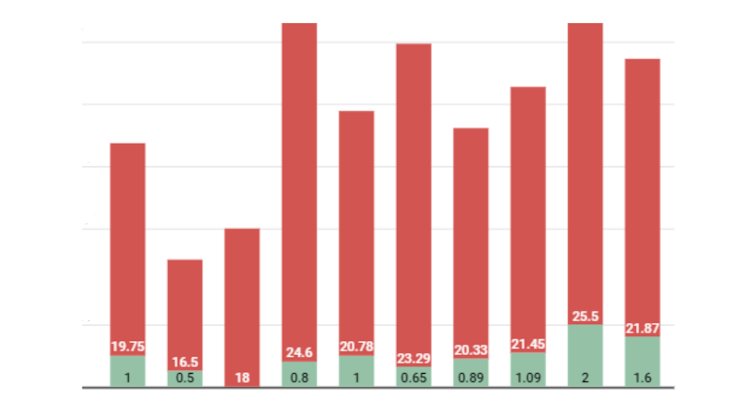BBL|10: The Stats And Trends Behind The Power Surge
Jan 15, 2021, 1:55AM
Cricket aficionados may be repulsed by the introduction of three new rules for BBL|10, but of those rules it feels as though the Power Surge has been the most accepted, and had the most genuine impact on the contest.
With 39 matches played, we decided to take a deep dive into the trends of the Power Surge in BBL|10.
First and foremost, it’s important to disclose that across the 39 matches, the surge has been used 37.5 times by the side batting first, with the Power Surge in the Gades-Thunder game halved due to rain, thus reducing the length of the game. Rain also forced the Heat-Stars game down to 10 overs, meaning no Power Surge was available for either side.
The Power Surge has been utilised only 31 times by the side batting second, with the drop-off coming for a variety of reasons, including rain, sides being bowled out and sides simply opting not to use it before they secured victory. On two occasions, victory was secured by the chasing side during the surge. These points will explain some variance in data.
RELATED: BBL|10: Analysing The Effect Of The Competition's New Rules
Power Surge Key Data
*The Renegades used the one-over Power Surge in the 13th over of the aforementioned rain affected Gades-Thunder match
The best timing of when to take the Power Surge has regularly been debated during the BBL TV commentary across both Channel 7 and Fox Cricket’s coverage. Across the course of the season, to date, using the Power Surge in the 15th and 16th overs has been most regular choice.
Indeed, those overs have also achieved on average 23.29 runs with only 0.65 wickets falling per surge. That’s a pretty good return.
The most fruitful average in terms of runs scored has been the 18th-19th, although that’s also been the period when the most wickets have fallen, likely due to sides taking increased risk given the lack of overs afterwards.
Runs Scored & Wickets Fallen During Power Surges
The 13th-14th overs have been an interesting success with the bat too, albeit only utilised five times.
Seldom has the Power Surge been taken immediately after the 10-over mark, with sides preferring to hold it.
In saying that, there’s been a discernible lean from sides batting first to take the Power Surge in the period between overs 15 and 17, with 19 of the 38 surges occuring then.
On the flip-side, chasing sides have only used the Power Surge three times in the final three-over period (with two of those sides winning the game within an over), while nine chasing sides have used the Power Surge in the 15th and 16th overs.
Batting 1st v Batting 2nd in Power Surge
Team by Team Power Surge Performance
Across the course of BBL|10, some teams have clearly been more successful in utilising the Power Surge compared to others, with the Heat able to generate the most runs on average, and by a reasonable distance, and without losing too many wickets.
Down the bottom, and by a long way, is the bottom-placed Melbourne Renegades, while the Hurricanes are struggling with both losing wickets and scoring runs.
The Scorchers appear to have taken a slow and steady approach to their Power Surges, losing 0.5 wickets per surge, whilst scoring at more than 23 runs on average. The Thunder have been fruitful but lost wickets generally.
That lends itself to our next table which concerns when certain teams have preferred to take the Power Surge.
Team by Team Power Surge Preference
There’s a few interesting outliers in this data, namely the Sixers’ clear preference to utilise the Power Surge in the 15th and 16th overs. All three times they’ve batted first they’ve done this, averaging 29.66 runs per surge, which is outstanding.
The Sixers have actually used all of their surges between the 11th and 16th overs.
In contrast, the Thunder have only utilised the Power Surge between the 14th and 20th overs, representing a vastly different strategy. That’s enabled the Thunder to take a more risky approach to their surge, hence the increased number of wickets which have fallen during this period.
Perth have taken five of their eight Power Surges during the 15th to 17th over range, four times when batting first.
There’s few discernible trends among the other teams, who seem to have taken a more ad-hoc approach to the Power Surge, deciding at the time on a needs basis.
RELATED: Take a look at the updated Stats Insider BBL Futures Model
Final Thoughts
With the Sixers, the Thunder and the Scorchers currently sitting in the top-three, it would appear there's something to be said about nailing down a Power Surge strategy that works.
Of all the new rules in BBL|10, the Power Surge feels like the one which has most genuinely made a tactical impact upon the actual contest.
Whether that’ll influence the finals placings or the ultimate crowning of the BBL|10 champion remains to be seen, but the evidence so far suggests it’s important to get right.
Did you enjoy this article? Join our free mailing list to get the best content delivered straight to your inbox, or join the conversation by leaving a comment below or on the Stats Insider Twitter or Facebook page.





